 South is indicated by the secondary top of a nearby hill [Pic].
South is indicated by the secondary top of a nearby hill [Pic].
North is precisely on a lower local hilltop [Pic].
In three out of four quadrants, the solstices and lunisticesLunistices are the most northerly and southerly moons of the month. The lunar equivalent of solstices - more. are marked by distant mountains. The easterly rise and western dip provide early warnings for the spring and autumn equinoxes.
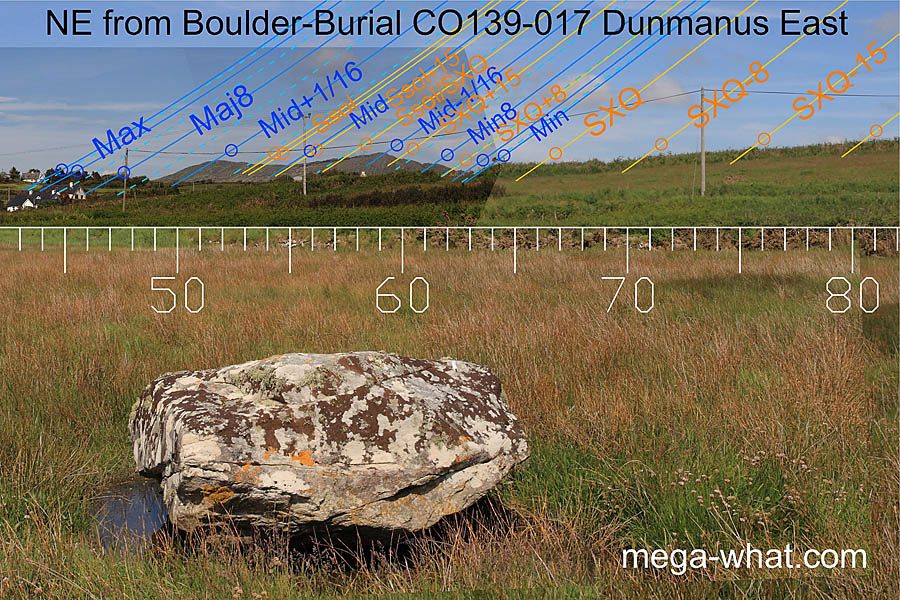 Its axis is north-east / south-west but is lowest to the north-east and points beyond major standstillLunistice positions vary cyclically over an 18.6 year period but are fairly static for more than a year at either end of the range
in that direction.
Its axis is north-east / south-west but is lowest to the north-east and points beyond major standstillLunistice positions vary cyclically over an 18.6 year period but are fairly static for more than a year at either end of the range
in that direction.
Knockaughna makes a very clear marker for the lunisticeLunistices are the most northerly and southerly moons of the month. The lunar equivalent of solstices - more. range. The notch between its twin peaks is the midpoint and its south base is at the minor end of the cycle, though a bank now interferes with the skyline there.
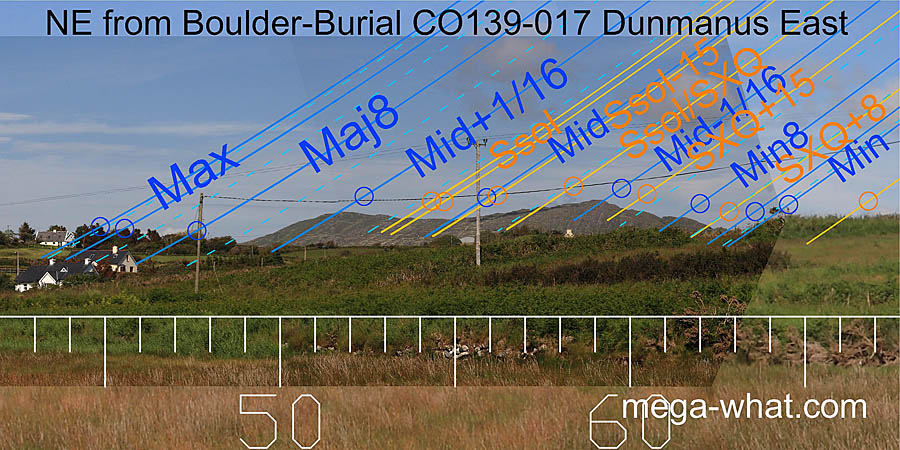 Both hilltops are lunar sixteenths and a subsidiary top on the south ridge is the lunar minor eighth.
This leaves the major eighth and major standstillLunistice positions vary cyclically over an 18.6 year period but are fairly static for more than a year at either end of the range
to occur a little beyond the hill's north base in an area now masked by trees and houses.
Both hilltops are lunar sixteenths and a subsidiary top on the south ridge is the lunar minor eighth.
This leaves the major eighth and major standstillLunistice positions vary cyclically over an 18.6 year period but are fairly static for more than a year at either end of the range
to occur a little beyond the hill's north base in an area now masked by trees and houses.
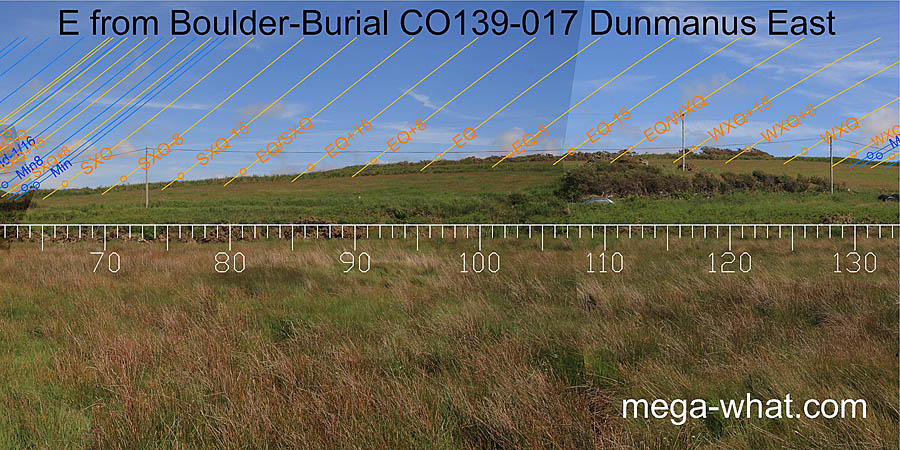 Eastwards, the broad local hilltop seems to be somewhere close to half-way between equinox and winter cross-quarters.
Eastwards, the broad local hilltop seems to be somewhere close to half-way between equinox and winter cross-quarters.
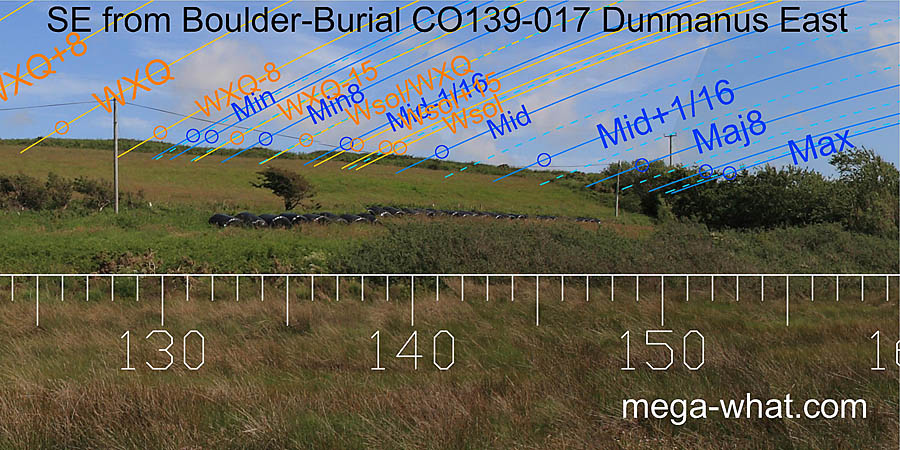 South lunisticeLunistices are the most northerly and southerly moons of the month. The lunar equivalent of solstices - more.
and winter sun rises are on the south slope of the local hill.
South lunisticeLunistices are the most northerly and southerly moons of the month. The lunar equivalent of solstices - more.
and winter sun rises are on the south slope of the local hill.
 Dominating the south-western view is the local hill of Dunmanus West, the north slope of which brackets the winter cross-quarters.
The south edge of the hilltop has a prominent rocky point which marks the lunar minor standstillLunistice positions vary cyclically over an 18.6 year period but are fairly static for more than a year at either end of the range.
Following the slope down to the south, one comes upon a prominent rock "knob" which makes a notable mark for the midpoint.
The solstice is at the hill's south basal step and the major end of the lunisticeLunistices are the most northerly and southerly moons of the month. The lunar equivalent of solstices - more.
range turns in the saddle at the bottom with major standstillLunistice positions vary cyclically over an 18.6 year period but are fairly static for more than a year at either end of the range
just at the beginning of the upslope on the other side.
In that area but below the ridge and behind some trees is Three Stone Row CO139-016.
Dominating the south-western view is the local hill of Dunmanus West, the north slope of which brackets the winter cross-quarters.
The south edge of the hilltop has a prominent rocky point which marks the lunar minor standstillLunistice positions vary cyclically over an 18.6 year period but are fairly static for more than a year at either end of the range.
Following the slope down to the south, one comes upon a prominent rock "knob" which makes a notable mark for the midpoint.
The solstice is at the hill's south basal step and the major end of the lunisticeLunistices are the most northerly and southerly moons of the month. The lunar equivalent of solstices - more.
range turns in the saddle at the bottom with major standstillLunistice positions vary cyclically over an 18.6 year period but are fairly static for more than a year at either end of the range
just at the beginning of the upslope on the other side.
In that area but below the ridge and behind some trees is Three Stone Row CO139-016.
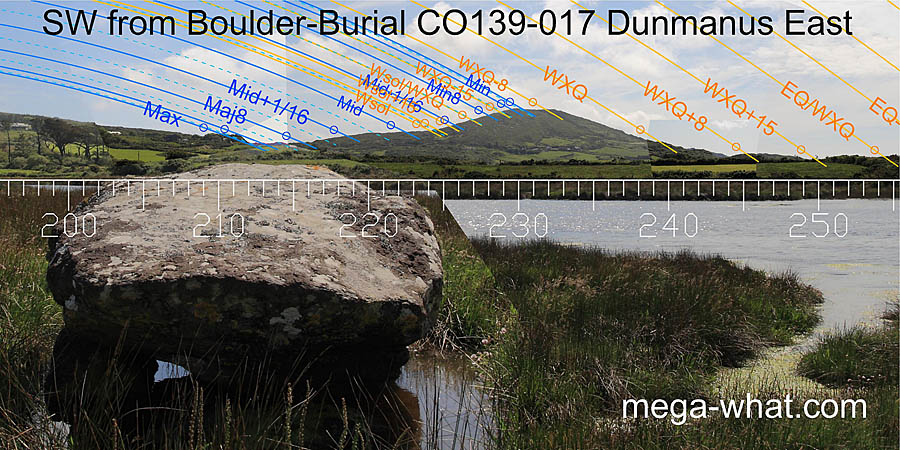 This Boulder-Burial has clearly been set that its axis indicates the major end of the lunisticeLunistices are the most northerly and southerly moons of the month. The lunar equivalent of solstices - more.
range to the south-west.
This Boulder-Burial has clearly been set that its axis indicates the major end of the lunisticeLunistices are the most northerly and southerly moons of the month. The lunar equivalent of solstices - more.
range to the south-west.
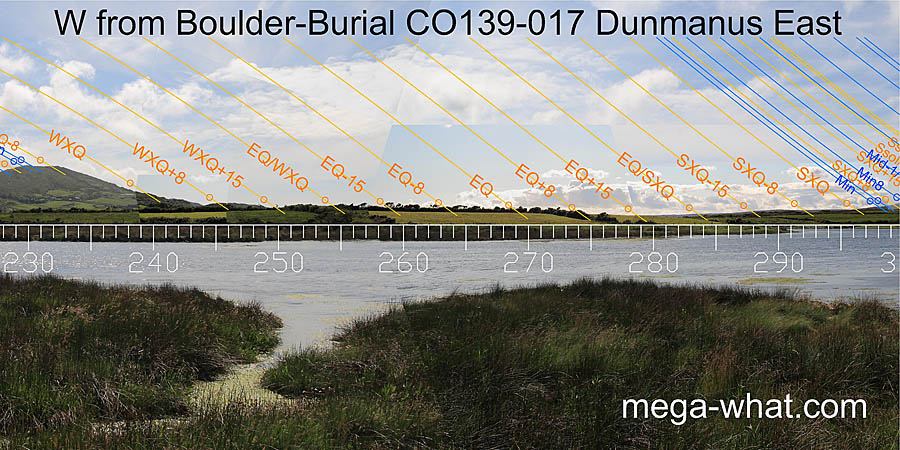 To the west, both winter and summer cross-quarters may be characterised as being at the foot of slopes. Half-way between them is a dip.
More precisely, the intersect of south and north banks of the estuary marks the midpoint
while the intersect of south bank and distant horizon is a half-month before autumn equinox.
To the west, both winter and summer cross-quarters may be characterised as being at the foot of slopes. Half-way between them is a dip.
More precisely, the intersect of south and north banks of the estuary marks the midpoint
while the intersect of south bank and distant horizon is a half-month before autumn equinox.
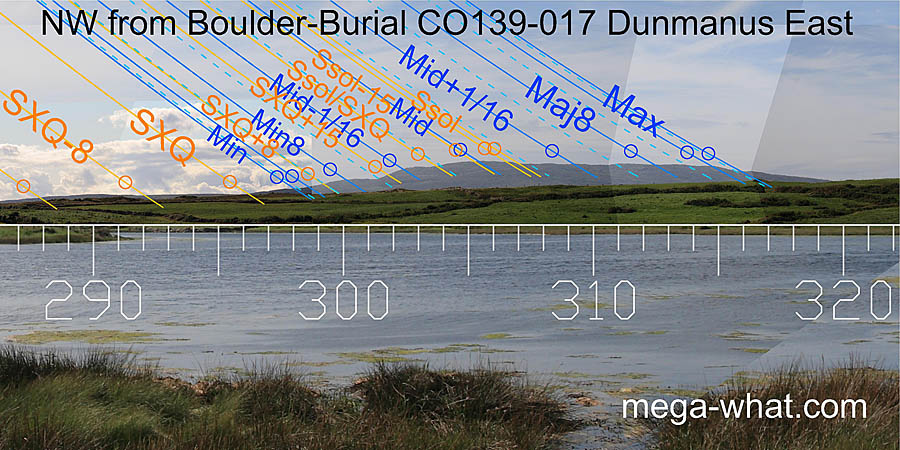 A mountain to the north-west has the summer cross-quarters at its foot with the lunar minor standstillLunistice positions vary cyclically over an 18.6 year period but are fairly static for more than a year at either end of the range
at first significant break above it.
The top marks the lunar midpoint and also delimits the month centred on the solstice.
Summer Solstice is at the north basal break of the top top and the lunar major standstillLunistice positions vary cyclically over an 18.6 year period but are fairly static for more than a year at either end of the range
is at the north basal break of the mountain top.
A mountain to the north-west has the summer cross-quarters at its foot with the lunar minor standstillLunistice positions vary cyclically over an 18.6 year period but are fairly static for more than a year at either end of the range
at first significant break above it.
The top marks the lunar midpoint and also delimits the month centred on the solstice.
Summer Solstice is at the north basal break of the top top and the lunar major standstillLunistice positions vary cyclically over an 18.6 year period but are fairly static for more than a year at either end of the range
is at the north basal break of the mountain top.
- Dunmanus Stone Row is 1.1km south-west (209°)
- Gorteanish Stone Circle & Boulder-Burials are across the sea, 6.2km north (6°)
- Cooradarrigan Boulder-Burials are 8.3km east (92°)
References
- Archaeological Survey of Ireland, record details. www.archaeology.ie/archaeological-survey-ireland
- Ó'NUALLÁIN, SEÁN 1978 Boulder-Burials. Proceedings of the Royal Irish Academy 78c:75-114, p94, no.28.
- POWER, D. et al. 1992 Archaeological Inventory of County Cork, Volume 1: West Cork. Dublin: Stationary Office. p32, no.117.
